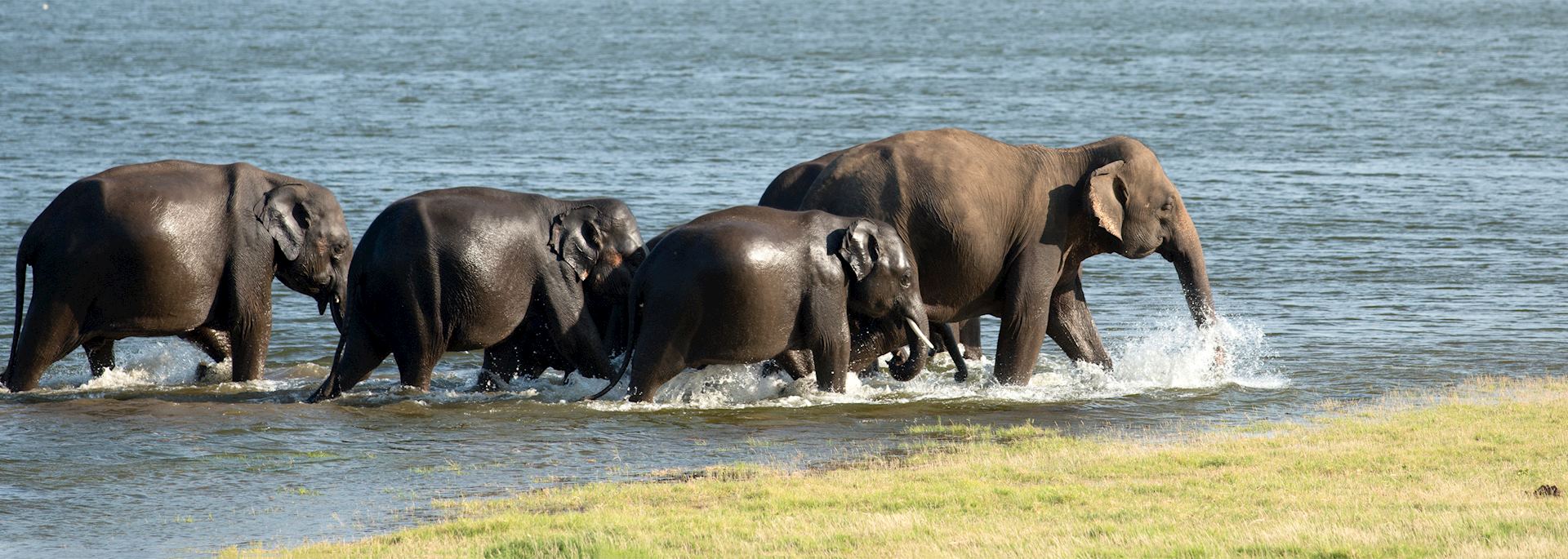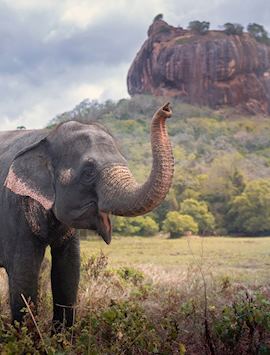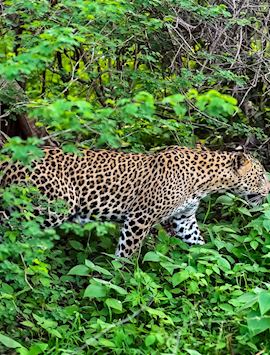By Sri Lanka specialist Seamus
Lakes, rivers, reservoirs and wetlands: Sri Lanka has an abundance of water. This flourishing ecosystem supports wildlife from shoals of tiny barb fish in the rivers to roaming elephant herds. The island is also on the migratory path for many birds, as my weighty book on Sri Lanka’s birdlife testifies.
Wherever you are in Sri Lanka, there’s usually a national park to visit close by, but the wildlife isn’t limited to the parks. You’ll see land monitors basking by the side of the roads and egrets flying over hotel grounds. I spotted a rare shikra (small bird of prey) from the car window. You can spot wildlife from the back of a jeep, but also on foot as you wander across hillside plains or hike through jungle.
Yala National Park: to seek out leopards

Yala relishes its title as the national park with the highest concentration of leopards in the world. Unfortunately, everyone knows it, so it can be quite busy. You need to join the line in the early morning to gain entry, and, due to the dense vegetation, animals sighting take a little patience.
That said, Yala offers a great all-round experience. The park stretches across Sri Lanka’s southeast coast, attracting a mix of wetland, coastal and jungle animals. Safaris here are by private jeep, accompanied by your guide. The guides and drivers are very focused on helping you get that elusive leopard sighting, knowing the animals’ commonly used tracks and which rocks they like to bask on.
If you are lucky enough to spot a leopard — I managed to see one up a tree, tail dangling languidly down — you can then choose to move onto quieter areas of the park. There are certain stretches that leopards, and consequently jeeps, rarely frequent. We left the other jeeps behind driving along lesser-visited tracks and were immediately rewarded with a statue-like crocodile on the side of a lake. Driving deeper into Yala, we passed a water buffalo rearing its head from the water.
My guide also pointed out signs that a sloth bear had been near (tell-tale scratches on the trees) though we didn’t manage to see one. You’ll catch sight of spotted and sambar deer across the park, as well as peacocks and the Sri Lankan junglefowl, the island’s national bird.
Although this isn’t the best park to sight elephants, they’re not subtle animals and are usually easy enough to find.
Where to stay in Yala National Park

For me, Yala has the best places to stay of any national park in Sri Lanka. There’s a range of choices on the border of the park, about 20 minutes from the main entrance. Stay a couple of nights to allow time for morning and afternoon safaris.
Jetwing Yala is a good-value option, with sea-facing rooms, a large pool and an extensive dining menu. But, my first choice would be Chena Huts, 14 thatched-roof huts scattered along the coast — each has its own pool. An all-inclusive property, games drives with experienced guides are included, as well as guided bush walks around the grounds. It’s a luxurious option (I shared one stay with the Moroccan royal family, who arrived by helicopter) but the wildlife still prevails — elephants have been seen walking right up to the huts.
Bundala National Park

If you’d like to stay in the Yala area longer, visiting Bundala National Park in a private jeep will add some variety to your wildlife watching. Bundala is a wetland park stretching 20 km (12 miles) along the coast to the west of Yala, an hour’s drive away. The lagoons, waterways and scrub forest shelter almost 200 bird species and, as the park is eclipsed by nearby Yala, are little visited.
I grew up near wetlands on the east coast of Ireland and, after getting my first pair of binoculars, spent my childhood learning the names of birds. Naturally, for me, Bundala was a real treat, and I managed to add a number of birds including painted storks, egrets and spoonbills to my ‘spotted in Sri Lanka’ list. Bundala also plays host to many migrating flamingoes, which usually arrive in September and stay throughout the winter.
Uda Walawe National Park: to see the elephant herds

A few hours’ drive west of Yala is Uda Walawe National Park. As it’s inland, the landscape is less vegetated, with open plains leading onto the Great Uda Walawe Reservoir.
Jackals, crocodiles, water buffalo and deer: I’ve seen them all up close, congregating at the waterside. The park’s most well-known residents, though, are elephants and, with a flourishing population, sightings are common.
Safaris in Uda Walawe National Park are by jeep, and you’re always accompanied by a guide. The elephants passed within touching distance of our jeep, unfazed by our presence (the babies seemed a little more curious, and one tiny trunk was bold enough to investigate our jeep door).
Leopards do live in the park but sightings are rare. For birdwatching it was ideal, as we found lots of peaceful corners to sit and watch the wildlife. I saw six types of eagle alone, as well as spoonbills and pelicans. At one point, a yellow-wattled lapwing, with neon-bright legs, wandered right up to the wheel of our jeep.
The Elephant Transit Home

A safari into Uda Walawe ties in well with a visit to the Elephant Transit Home, about an hour’s drive away. Supported by the Born Free Foundation, the home cares for and rehabilitates orphaned elephants to ready them for release back into the wild (at about four years old). The best time to visit is for one of the feedings: at 9am, 12 noon, 3pm and 6pm.
Standing at a respectful distance on a raised platform, you can watch the elephants being guided into the feeding enclosure. Most need little encouragement, their ears flapping madly as they career toward the entrance, trunks jostling excitedly to be let in. The tiny elephants feed on milk — by pulling on a tube from raised bags of milk to avoid human contact — the older animals on large piles of foliage.
Where to stay in Uda Walawe National Park

I suggest staying a couple of nights in Uda Walawe, which allows time for dawn and dusk safaris into the park. The places to stay are simpler than in Yala, but I find Kalu's Hideaway a comfortable choice. It’s owned by retired cricketer Romesh Kaluwitharana, and the lobby is decorated with cricket memorabilia. In-between the day’s safaris, you can relax in a hammock in the hotel grounds, or make use of the pool.
Sinharaja Biosphere: for wildlife spotting on foot

A UNESCO World Heritage Site, Sinharaja Biosphere is Sri Lanka’s last surviving area of primary tropical rainforest. It lies to the west of Uda Walawe and gives you an opportunity to explore Sri Lanka’s wildlife on foot at a slower pace. A network of narrow trails cross the reserve’s ridges and valleys, which are best negotiated with an experienced guide.
You won’t see many large animals through the thick vegetation — this is a place for appreciating insects, butterflies, lizards and birds. More than 50% of Sri Lanka’s endemic species can be found here, and more than half of these are considered rare. Many of Sri Lanka’s medicinal plants grow here too, as well as some outlandish mushrooms, including the veiled lady, so-named for its lace-like, spore-containing ‘skirt’.
Where to stay in Sinharaja Biosphere

Rainforest Edge, as the name suggests, is a hotel close to the park’s entrance. It’s simple but comfortable with reclaimed wooden furniture and a spacious pool area. No-one’s told the wildlife where the park ends, so you’ll often see butterflies, birds and the occasional monkey exploring the hotel grounds.
Minneriya National Park: an alternative to the southern parks

If you’re planning a short visit to Sri Lanka, or want to limit your amount of travel time, Minneriya National Park is a good alternative to the southern parks, such as Yala.
Minneriya is near Sri Lanka’s Cultural Triangle of ancient capital cities, temples and fortresses. You can fit in an afternoon safari after climbing Sigiriya Rock, which rises 200 m (656 ft) above the surrounding countryside, or before visiting the ruins and Buddha at Polonnaruwa, where Sri Lankan kings once ruled.
The park contains the Minneriya Tank, a reservoir dating from 200 AD that was built by a Sri Lankan king to irrigate the surrounding fields. From July to August, when the waters are at their lowest, elephants travel across Sri Lanka to the tank to drink. This event, known as ‘the Gathering’, is the largest assembly of Asian elephants in the world. During the rest of the year it’s still possible to spot elephants, albeit in much smaller numbers.
Horton Plains National Park: wildlife in the hill region

Up in the hills of Sri Lanka, away from the safari parks, are the sweeping plains of Horton National Park. British colonists nicknamed the area ‘little England’ such were its similarities with British pastoral landscapes. For the best views, visit the park in the early morning before the cloud cover settles.
My guide and I took a scenic walk through the park, following a circular loop. The first section of the trail was surrounded by vegetation on all sides, sheltering a range of bird species. We spotted oriental white-eyes and dull-blue flycatchers.
The trail leads past World’s End, an 800 m (2,624 ft) drop with views to the valley floor below, it was a good place to pause and enjoy a packed breakfast. The wild grasslands feed a healthy sambar deer population and purple-faced langurs dart between the patches of forest.
Where to stay in Horton Plains National Park

The colonial tea-planter’s town of Nuwara Eliya is the best base for visiting Horton Plains. It’s a five-hour drive from Colombo, or a slow but scenic train journey from Kandy to the north.
Warwick Gardens is a Scottish tea-planter’s house set in tea fields outside the town, about an hour’s drive from the park. The owners took seven years to restore the property and turn it into a hotel that feels like home.
Gal Oya: for intrepid wildlife experiences

Home to forest-dwelling tribes and swimming elephants, and a challenge to visit, Gal Oya National Park has rather a mythical air in my mind. In recent years, hoteliers have negotiated with the tribespeople to build ten-bungalow Gal Oya Lodge near the park’s border, opening up this area to visitors.
Gal Oya is on the east of the island, and you can travel from Yala National Park, a relatively smooth three-hour drive (until you get to the hotel’s access road, which requires a jeep), or a four-hour winding road route from the tea region.
As you drive toward Gal Oya Lodge, the scrubland turns into ever-thickening forest. At the lodge, I was met by my naturalist, who would arrange my itinerary during my stay — it’s best to plan your activities on arrival, making the most of recent animal sightings.
I opted for a boat safari on Gal Oya Reservoir, Sri Lanka’s largest man-made body of water. We caught the boat from the side of the dam and immediately began to skirt around the rocky islands poking out from the water.
One island seemed to be covered in a continuously moving mound of gray — this was bird island. Flocks of birds, mostly ibises, grey herons and Oriental darters, have nested on every inch of the island — made more bizarre by the fact that they have passed up the surrounding, empty islands.
There’s a healthy elephant population in Gal Oya. My guide explained that, during the wet season, it’s possible to see the elephants swimming between the islands — but it’s not an everyday occurrence. There were no elephant sightings during my visit, but we did manage to spot a grey-headed fish eagle, and torque monkeys swinging between the trees. We stayed on the lake until sunset, watching the water light up with flecks of orange and pink.
During my stay at Gal Oya Lodge, I also took a guided walk into the surrounding forest with the chief of the Vedda, the indigenous people of the area. A translator joined us, but the chief had such an expressive personality that we managed to communicate using mostly facial expressions and hand gestures. He showed us — and encouraged us to taste — many medicinal plants and flowers, as well as seeking out some interesting insects. The pseudoscorpion, a sneaky, harmless arachnid that looks just like a scorpion, was particularly memorable.
Start planning your wildlife trip to Sri Lanka
Start thinking about your experience. These itineraries are simply suggestions for how you could enjoy some of the same experiences as our specialists. They're just for inspiration, because your trip will be created around your particular tastes.
View All Tours in Sri Lanka




